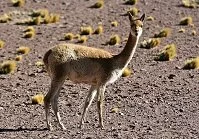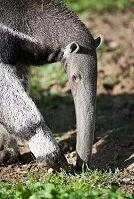Wildlife

Cougar (Puma)
Bolivia is a landlocked country at high altitude, which somewhat limits the wildlife in the country. Despite this, the country has numerous areas at lower elevations so the wildlife is more diverse than one would initially believe. This diversity is very limited area to area; at elevation there tends to be one set of animals, while at lower elevations many of those plants and animals are absent, but a new set exists.
The mammalian life in Bolivia is well adjusted to the altitude as most of the wildlife is native to the Andes, or at least fits in with the alpine nation. A couple of the continent's most iconic animals are native to Bolivia including the llama, alpaca, vicuna (a camel species), cougars (puma), wolves, foxes, and deer. Smaller mammals and rodents also like the high altitude as the chinchilla (a local rodent), opossums, rats, squirrels, mice, rabbits, and bats are common. The tapir, sloth, armadillo, anteaters, and porcupine can sometimes also be found at lower elevations.

Vicuna
Unlike the native mammalian life, Bolivia's sea life is almost non-existent. The country has no ocean access so their sea life is limited to the animals in their lakes and rivers. In the cold waters these animals are again very limited, but include some species of catfish, pike, and a few other freshwater fish.
However, the bird life is fairly significant as numerous birds love the alpine conditions as Bolivia has no shortage of birds, especially large birds. Condors, eagles, egrets, and the Andean flamingo are all common in Bolivia; the flamingos especially love the salt flats. Owls, partridges, coots, geese, finches, woodpeckers, and other birds can also be found in the lower forests.
The reptilian, amphibian, and insect life in Bolivia are somewhat limited, but definitely present, especially at lower elevations. Many of these animals are spiders, including the tarantula, and snakes, including the rattlesnake. Few insects can survive at high elevations, however flies, mosquitos, butterflies, and other insects can be found at lower elevations.

Anteater
When it comes to native plant life, South America is home to many famous edible plants and these plants quickly spread throughout Bolivia, South America, and beyond. The pineapple is from the region where Brazil and Uruguay meet while potatoes and tobacco originated in the Andes Mountains; in fact some believe the potato is from the Lake Titicaca region. A few others, including cacao trees (used to make chocolate), peanuts, and tomatoes are also from South America, although their actual origin is unknown. Peppers, both sweet and hot peppers are from Central America or northern South America while vanilla, avocado, papaya, and corn (maize) are likely from Central America itself. No matter each food's origin, what is known is that these foods spread throughout the continent and to the country of Bolivia with the help of pre-historic people, animals, and winds. These people have had these foods for nearly as long as people have inhabited the region and each makes an important part of the people's diet and culture now and for thousands of years into the past.
In addition to these famous fruit bearing plants, Bolivia has a wide variety of trees and other plants. Numerous sturdy reeds are found in Lake Titicaca and used to make boats; quinoa, rubber trees, and many hard woods are also common in the country.